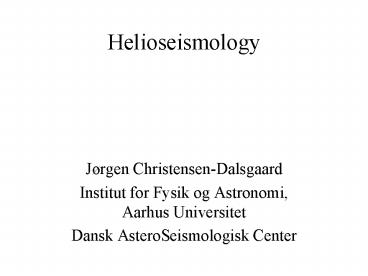Helioseismology - PowerPoint PPT Presentation
1 / 31
Title:
Helioseismology
Description:
Helioseismology. J rgen Christensen-Dalsgaard. Institut for Fysik og Astronomi, ... The start of global helioseismology. Grec et al. (1980; Nature 288, 541) ... – PowerPoint PPT presentation
Number of Views:55
Avg rating:3.0/5.0
Title: Helioseismology
1
Helioseismology
- Jørgen Christensen-Dalsgaard
- Institut for Fysik og Astronomi, Aarhus
Universitet - Dansk AsteroSeismologisk Center
2
The Sun
3
Five-min oscillations A local phenomenon in the
solar atmosphere?
Musman Rust (1970 Solar Phys. 13, 261)
4
Oscillation modes of the Sun
Deubner (1975 Astron. Astrophys. 44, 371)
5
The start of global helioseismology
Grec et al. (1980 Nature 288, 541)
6
Crucial advantages
- Access to modes of degree up to 1000
- Observations over very extended period (more
than 10 years nearly continuously) - Well-determined global parameters
7
Frequencies of solar model
n w / 2 p
8
Asymptotics of frequencies
Acoustic-wave dispersion relation
9
Rays
10
Inversion with rays
11
Observing a Doppler image
12
Data on solar oscillations
Observations MDI on SOHO
13
Observed frequencies
m-averaged frequencies from MDI instrument on
SOHO 1000 s error bars
14
Frequency dependence on solar structure
Frequencies depend on dynamical quantities
15
Frequency differences, Sun - model
16
The solar internal sound speed
Sun - model
17
The solar internal sound speed
Sun - model
Basu et al. (1997 MNRAS 292, 243)
18
Changes in composition
- The evolution of stars is controlled by the
changes in their interior composition - Nuclear reactions
- Convective mixing
- Molecular diffusion and settling
- Circulation and other mixing processes outside
convection zones
19
Relativistic electrons in the Sun
Elliot Kosovichev (1998 ApJ 500, L199)
20
(Spaceflight Now 14 Aug 2005)
21
Revision of solar surface abundances
Asplund et al. (2004 AA 417, 751. 2005
astro-ph/0410214 v2)
- Improvements
- Non-LTE analysis
- 3D atmosphere models
- Consistent abundance determinations for a variety
of indicators
22
How do we correct the models?
Basu Antia (2004 ApJ 606 L85) an opacity
increase to compensate for lower Z is required
Seaton Badnell (2004 MNRAS 354, 457) recent
Opacity Project results do indicate some increase
over the OPAL values, but hardly enough
Antia Basu (2005 ApJ 620, L129) could the
neon abundance be wrong?
23
The neon story
Ne x 2.5
Bahcall et al. (2005 ApJ, in the press
astro-ph/0502563)
Drake Testa (2005 Nature 436, 525) X-ray
observations of nearby stars indicate such a neon
increase
24
Spherical harmonics
25
Rotational splitting
26
Simple rotational splitting
27
Kernels for rotational splitting
28
Kernels for rotational splitting
(5,2)
(20,8)
(20,17)
(20,20)
29
Inferred solar internal rotation
Schou et al. (1998 ApJ 505, 390)
30
Rotation of the solar interior
BiSON and LOWL data Chaplin et al. (1999 MNRAS
308, 405)
31
Tachocline oscillations
? GONG-RLS ?MDI-RLS ? MDI-OLA
See Howe et al. (2000 Science 287, 2456)
32
Zonal flows
Rotation rate - average value at solar minimum
Vorontsov et al. (2002 Science 296, 101)
33
Radial development of zonal flows
Howe et al., (ApJ, in the press)
34
Observed and modelled dynamics
6 1/2 year MDI inversion, enforcing 11-yr
periodicity Vorontsov et al. (2002 Science 296,
101)
Non-linear mean-field solar dynamo models Covas,
Tavakol and Moss (2001 Astron. Astrophys 371,
718)

